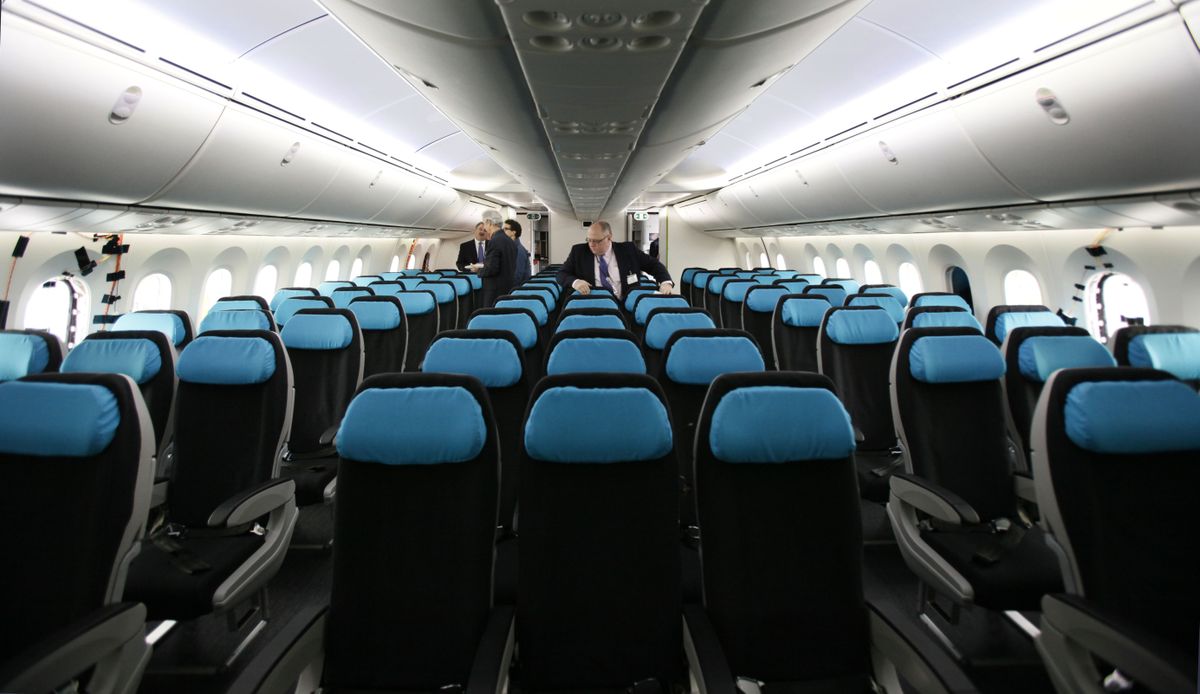Boeing tests inside of new 787

EVERETT — Boeing Co. designers and marketers are betting that a lot of subtle changes in the interior of their new 787 jetliner will add up to strong passenger demand to fly on the plane.
Boeing Commercial Airplanes on Wednesday showed off the first 787 with a passenger cabin installed. The plane, the third 787 to be built, is among six that Boeing is using in its flight test program this year.
While the other aircraft will test flight characteristics and aircraft strength, this plane, scheduled to fly later this month, is dedicated to cabin features and safety — the “passenger experience” as Boeing describes it. Everything on board, from the ventilation system to the coffee pots, must be certified by the Federal Aviation Administration before 787s can go into passenger service.
Bigger windows that are dimmed electronically, mood lighting, more spacious lavatories and other features all were carefully chosen to please passengers, said Tom Galantowicz, the company’s director of 787 interiors. Among the “very simple things,” he said, are more convenient latches on the larger overhead baggage bins.
The bins, which swing up and away, also allow more headroom. Lavatories have imitation tile floors and toilet seats that close electronically — no need to touch should the previous occupant thoughtlessly leave it up.
The initial 787-8 model will carry 210 to 250 passengers on routes of up to 9,400 miles, such as New York to Hong Kong. Aircraft comfort becomes important on such long flights.
Airlines especially want to attract higher-paying business-class passengers for those flights, said Kent Craver, Boeing’s regional director for passenger satisfaction and revenue.
“Business passengers tend to chase the aircraft equipment they like and they will actively seek out those aircraft types,” he said.
Boeing undertook an unprecedented global study of airline passengers to see what they liked, said Blake Emery, Boeing’s director of differentiation strategy.
“We were looking for the deep psychological needs that people have when they’re inside an airplane,” he said.
The research, Emery said, found that people making their first flight were fascinated, while experienced, economy-class passengers said they wanted “no one in the seat next to them, and they slept all the way.”
The 787, with its higher ceilings and more space just inside the doors, presents “an architectural welcome” for passengers who have just endured a cramped, crowded jetway, Emery said.
The cabin’s LED lights have a full range of colors, with airlines able to pick different lighting schemes during the flight, including a sky blue while boarding and “warm lighting” to make the food look better. Cabin pressure is lower than in earlier aircraft, which should make people feel better during and after a flight, designers said.
Boeing officials say many of these features could be adopted in their other models, including the 737.
The test plane is spartan, with only economy-class seats and its midsection filled with nine racks of electronics and workstations for engineers. Orange test wires run throughout the cabin and several windows have been replaced with test instruments.
Besides making sure all the passenger comforts work, the jet will test cabin safety systems, including oxygen masks, evacuation slides and methods of fighting onboard fires, said Derek Muncy, a flight test engineer.
In the air, engineers will fill its 135 seats with passengers to check air circulation and to see how the cabin responds to their body heat. They also will load the galleys with food and drink and cook 100 meals while airborne, Muncy said.
The 787 is the first passenger jet to be made mostly from composite materials. Boeing says it will use far less fuel, be quieter and produce lower emissions than comparable planes and should save airlines money on maintenance.
The first flight of the 787 was in December, after which Boeing began its nine-month test program. Late this year, Japan’s All Nippon Airways is to receive the first plane to be put into service, more than two years overdue because of production problems and other glitches that have cost Chicago-based Boeing billions of dollars.
So far, Boeing has produced 12 787s at its Everett plant, with four more on the assembly line. Customers have ordered 851 of the jets.